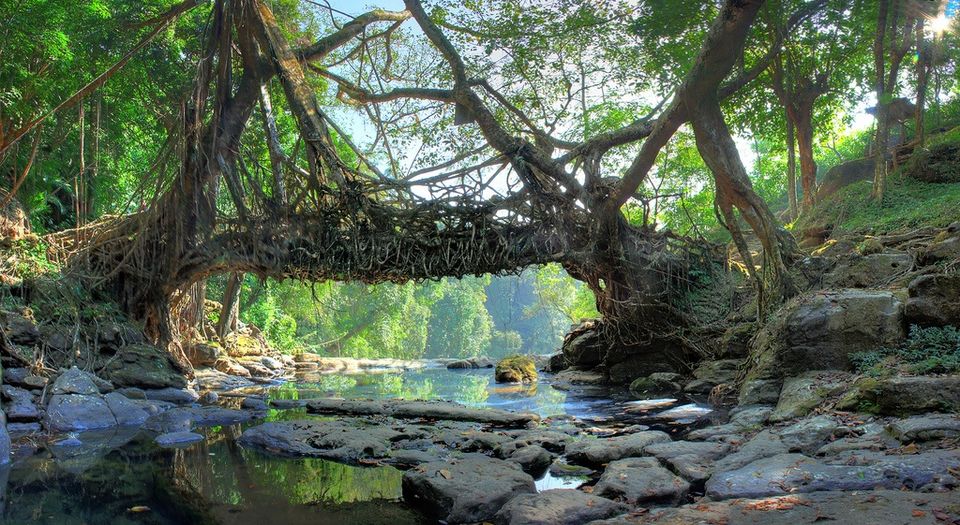

Living Root Bridges in Meghalaya
There are some journeys in life which are hard to forget. My trek to the much talked about Double Decker Root Bridge in Meghalaya was one such journey for me. I usually trek alone and do not really think too much about the risks involved in the forest as I feel that most of the answers to my deepest questions lie there. As always the forest did talk to me and answered a lot of pending questions I had.
My journey started from Guwahati to Shillong(3-4 hours) and from there to Cherrapunji (2 hours). After an overnight stay there, I started at 8 a.m. to reach Tyrna the base village which is 20 km from Cherrapunji. I learnt that the fastest means to reach Tyrna was by hitch hiking as there is no fixed time for the buses.
I started walking with the hope that I’d get some vehicle, but it came only after I’d covered 5 km. It was a jam-packed mini bus and the only place I could get was on the top! It was quite an experience riding on the top downhill through narrow roads with thick forest all around.
After reaching Tyrna I had to walk down another 1.5km to reach the the lower part of the village Tyrna. It was very amusing for me to be greeted by every single kid as I entered the village with ‘”Hello, what is your name?” After asking for directions from a kid, I finally started my hike in the wrong direction! I realized only after 45 min down the hill when I came across a wood cutter who told that I’d taken the exact opposite direction . I had to take a cemented way to the left but I took the right as there was a cement way there as well, which leads to nowhere but a muddy path into the forest.
I climbed back to the village and took directions from 3 different people to be really sure. This time I was in the right direction as I found few wooden planks hung on trees showing the right direction. It was a 3000 step journey down the hill with villagers greeting me on the way. After almost 20-30 minutes I reached a small village which I thought was the village with the bridge, but it was another 40 min from there. At this stage I hit a patch of stoned pathway through arecanut trees. At the end of the patch of arecanut trees was a very small board nailed to a tree indicating the way to the double decker bridge.
I was rushing as I had very little time to get back before sunset. Being in the east the sun fades away by 4.30 pm in the winters and I was still 20 km away from Cherrapunji and uncertain about transportation back. I met a villager with whom I confirmed my route again, which sparked off a casual conversation. He told me that during the end of the monsoon there are few who come down and stay there, as the beauty of the place is at its peak with countless waterfalls. Promising myself to return to the place at- least once in the monsoon, I continued my descent.
The journey from the second village to the middle to the final village is the part which makes the whole hike memorable. After descending through a patch of steps made of stones (not cemented) I came across two hanging bridges over rain fed rivers. The bridges were made of rusty iron cables repaired and supported with bamboo with some parts held together with steel wires. The whole bridge shakes and swings and the water flowing 20-25 feet below makes the whole experience fantabulous. I was alone while crossing the bridge and all I could hear were the sounds of the squeaking cables, the water flowing below and my involuntary chanting of Sri Ram!
I stopped and looked down at the water flowing and the forest surrounding it. That was the time I actually started enjoying myself. I shook the bridge and it started swinging. I jumped a few times- it swung again. So much fun! Then realizing that time was running out I started running again. I had to cross one more rusty bridge which was actually made up of two parts and even longer than the first. This one looked in a bad shape with more intertwining of old rusty cables supported with somewhere in the bamboo from below.
I reached Nongriat village where the bridge is located. To reach the bridge, you have to take a right turn near a board put up by the Government which gives info of entrance fee. I just went ahead and no one asked for the entrance fee either. The path from the village just took a minute – and there it was – the much talked about Double Decker Root Bridge!
I went around looking with awe at the living root bridge, built patiently by the villagers from generation to generation, patiently guiding the roots of the rubber trees across the river with the necessary supports. It is two bridges stacked one over the other and one of its kind in the entire world. It’s truly a wonder in itself. I was told it can take up to 50 people at once. This natural bridge is said to be over 200 years old and, like the rest, just gets stronger over time – unlike man made bridges.

To my surprise, there was a guest house with minimum facilities for Rs.400/ per day. They asked if I wanted to stay back for a night and came down to Rs.200 but I had different plans. There was also a small shop which sold cool drinks, Amul kool, biscuits and chips.
After clicking a few photographs I came back to Nongriat and started my climb back to Tyrna again through the swinging bridges. It did not take as much time and effort as I’d thought looking at the steep steps. I took two breaks during the climb and reached Tyrna. When I asked for the next bus, the locals said that I might get shared taxis faster as the next bus was only by 4 in the evening and they were right. Shared taxi did come and I had a comfortable ride back to lower Cherrapunji.
How to do this trek:
Getting to/from: Simple route from Tyrna village (20km from Cherrapunji).
Guides and Porters: Not necessary as the whole path is cemented and one can find villagers along the way.
Total Distance: 7 km
Weather: Expect pleasant weather except in Monsoon season.
Permits: None.
More about the hike and places around :
The whole path is cemented and there’s hardly any deviation once you take the correct path from lower Tyrna, i.e the path on the left side. The best part of the hike to me was around the hanging bridges and if the water level is low I’d recommend you to go down on a rocky path under the bridge and see the view from there. Standing still in the middle of the shaky bridge is a must! Staying at the Inspection bungalow in lower Cherrapuni(Sohra) is highly recommended due to its beautiful location as it could be a place where you can dump your luggage and hitch hike(recommended) or book your own cab to Tyrna though that could be a bit boring. If you have time you can also go to Mawsmi caves and Noh Ka Likai falls which are 5 km and 6 km respectively from Cherrapunji (Sohra).
Frequent Searches Leading To This Page:-
meghalaya tourism hotels, meghalaya, shillong tourism, budget holiday package for meghalaya, cheap meghalaya tour package, meghalaya affordable tour packages




